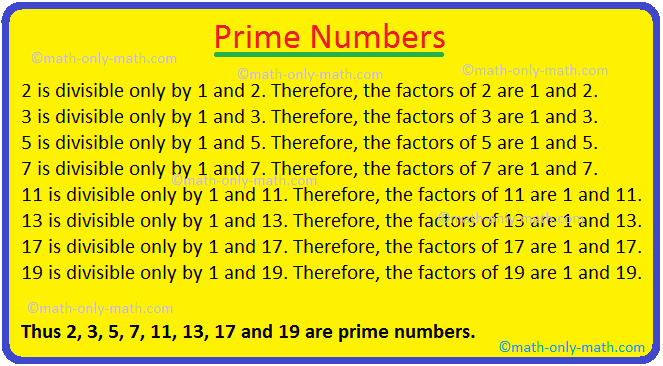Subscribe to our ▶️ YouTube channel 🔴 for the latest videos, updates, and tips.
Prime Number
What is prime number?
A number which is divisible by only itself and 1 is a prime number. So, prime number has only two different factors normally 1 and the number itself.
A whole number having only 2 factors is called the prime number.
The two factors of a prime number are 1 and the number itself.
Let us find all the factors of 2, 3, 5, 7, 11, 13, 17 and 19.
(i) 2 → the factors are 1 and 2.
1 × 2 = 2
2 × 1 = 2
(ii) 3 → the factors are 1 and 3.
1 × 3 = 3
3 × 1 = 3
(iii) 5 → the factors are 1 and 5.
1 × 5 = 5
5 × 1 = 5
(iv) 7 → the factors are 1 and 7.
1 × 7 = 7
7 × 1 = 7
(v) 11 → the factors are 1 and 11.
1 × 11 = 11
11 × 1 = 11
(vi) 13 → the factors are 1 and 13.
1 × 13 = 13
13 × 1 = 13
(v) 17 → the factors are 1 and 17.
1 × 17 = 17
17 × 1 = 17
(vi) 19 → the factors are 1 and 19.
1 × 19 = 19
19 × 1 = 19
Therefore,
2 is divisible only by 1 and 2. Therefore, the factors of 2 are 1 and 2.
3 is divisible only by 1 and 3. Therefore, the factors of 3 are 1 and 3.
5 is divisible only by 1 and 5. Therefore, the factors of 5 are 1 and 5.
7 is divisible only by 1 and 7. Therefore, the factors of 7 are 1 and 7.
11 is divisible only by 1 and 11. Therefore, the factors of 11 are 1 and 11.
13 is divisible only by 1 and 13. Therefore, the factors of 13 are 1 and 13.
17 is divisible only by 1 and 17. Therefore, the factors of 17 are 1 and 17.
19 is divisible only by 1 and 19. Therefore, the factors of 19 are 1 and 19.
Thus 2, 3, 5, 7, 11, 13, 17 and 19 are prime numbers.
Note:
(i) All prime numbers except 2, are always odd numbers.
(ii) The number 2 is a prime as well as an even number.
(iii) All prime numbers are exactly divisible by 1 and the number itself.
From Prime Number to HOME PAGE
Didn't find what you were looking for? Or want to know more information about Math Only Math. Use this Google Search to find what you need.



New! Comments
Have your say about what you just read! Leave me a comment in the box below. Ask a Question or Answer a Question.